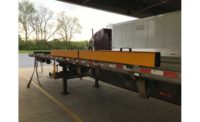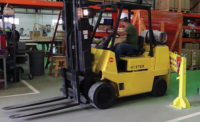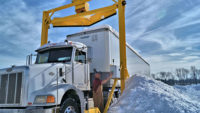Automated loading dock equipment a boon for aging workforce
Eliminate backbreaking manual labor

Credit: LongHa2006 / Getty Images Plus
America’s workforce is aging. According to AARP, nearly half of new jobs in the U.S. last year were filled by workers 55 years or older. Due largely to ongoing labor shortages, this disproportionately small demographic accounted for more than 1.4 million of the 2.9 million new jobs in 2018, many of them in the fast-growing sector of warehousing and distribution centers.
Industrial facilities have generally embraced labor-reducing automated equipment inside the plant, but one area of operations typically lags behind. All too often, workers on loading docks still use manually operated equipment and procedures.
Thanks to a host of new technologies, though, these activities no longer need to require tiring, potentially dangerous physical exertion – a huge benefit for those over age 55.
From automatic vehicle restraints to push-button hydraulic levelers with smooth transition features, new technology is reducing “backbreaking” manual loading dock labor. High-tech, interlocked dock control systems are a prime example of how modernized equipment makes materials handling safer, more efficient and more ergonomically sound for employees of all ages.
Automatic vehicle restraints
Less than 40 years ago, trailers were secured manually to a facility’s loading dock bay. For example, workers would need to go outside, regardless of weather and environment, and physically set wheel chocks on a trailer’s rear tires once positioned at the dock. Some facilities still use this dangerous practice, which places employees out on the busy drive approach. Plus, wheel chocks themselves are the most basic, antiquated form of vehicle restraint technology.
These types of manual operations are not only time-intensive, but potentially dangerous. OSHA recently reported that tractor-trailers are the second leading cause of back-over deaths in the United States. Internationally, recommendations are also being made to keep valued employees off the dangerous drive approach with the help of back-up alarms employed on semis and bumper refuge zones. Thankfully, with today’s technology and changing standards, there is little to no reason for employees to go outside on the dangerous drive approach to chock tires.
Automatic restraints can work by locking onto the trailer’s wheels or – more commonly – its rear impact guard (RIG). They’re operated with a simple push of a button. This level of automation helps docks operate more safely and efficiently, in addition to keeping workers off the dangerous drive approach. Automatic vehicle restraints also help prevent trailer separation accidents, such as a truck driver prematurely pulling away from a dock when a forklift is still inside – creating a potential fatality for the forklift operator.
Push-button levelers
Once the trailer is secured to the loading dock, forklift operators and workers must bridge the gap from facility floor to the back of the trailer with a dock leveler. Mechanical levelers that require a worker to pull a chain might be sufficient for operations that do not have a high volume of trailers to service and do employ a young workforce. However, for aging workers and high-volume operations, it’s important to take a long look at hydraulic levelers.
Using a push-hold button on a control box, hydraulic levelers provide workers the luxury of only needing to lift a finger to raise and lower a heavy hydraulic leveler. Considering the average loading dock leveler services on average eight trucks per day, that’s saving a lot of bending over and pulling; not to mention backaches and trips to the chiropractor.
Loading dock control systems
Traditionally, the various pieces of loading dock equipment – including vehicle restraints, levelers and overhead doors – were operated independently of each other. The most advanced dock controls now seamlessly integrate these systems.
It starts with the vehicle restraint. Once it is engaged with a RIG or rear wheels to secure the trailer, the vehicle restraint enables dockworkers to use other equipment in a safe sequence of operations.
For instance, these systems can be programmed with a green light interlock, which disables the use of the hydraulic leveler or overhead door until the vehicle restraint is safely engaged; an overhead door interlock, which requires overhead doors to be opened prior to leveler operation; or a stored leveler interlock, which ensures that the leveler is stored safely before the restraint can release the trailer. This type of control panel helps eliminate the potential for human errors when it comes to operating equipment at the loading dock door.
These advanced control systems use a modern user interface with membrane switch buttons. NEMA 4X rated, these control systems are built to withstand the harsh conditions of a loading dock to meet requirements for electrical noise and harsh environmental conditions. In addition, they have flexible circuitry and can be modified to update components or add features as needs change or budgets allow.
Automating safety at the loading dock
Working on a loading dock doesn’t have to be a pain in the neck (or back). Facility managers looking to improve working conditions for aging workers – and all employees on the loading dock – should consider automated solutions. Advanced equipment can also simultaneously improve efficiency and safety.
Automatic vehicle restraints, hydraulic levelers with smooth transition features and interlocked loading dock control systems are three ways facilities can provide ergonomic safety solutions for workers. If your facility is still using wheel chocks, mechanical levelers or levelers designed without smooth transition technology, it is time for an upgrade.
The information in this article is provided as a general reference regarding the use of the applicable product(s) in specific applications. This information is provided without warranty. It is your responsibility to ensure that you are using all mentioned products properly in your specific application and in accordance with all laws and regulations.
Looking for a reprint of this article?
From high-res PDFs to custom plaques, order your copy today!









